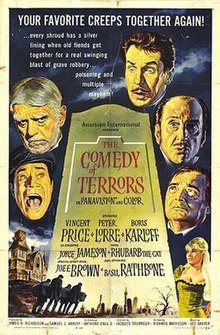
Béla Ferenc Dezső Blaskó, known professionally as Bela Lugosi, was a Hungarian–American actor, best remembered for portraying Count Dracula in the 1931 horror film classic Dracula, Ygor in Son of Frankenstein (1939) and his roles in many other horror films from 1931 through 1956.

Peter Lorre was a Hungarian and American actor, active first in Europe and later in the United States. He began his stage career in Vienna, in the Austro-Hungarian Empire, before moving to Germany where he worked first on the stage, then in film in Berlin in the late 1920s and early 1930s. Lorre caused an international sensation in the Weimar Republic–era film M (1931), directed by Fritz Lang, in which he portrayed a serial killer who preys on little girls. Known for his timidly devious characters, his appearance, and his accented voice, Lorre was frequently caricaturized during and after his lifetime and the cultural legacy of his persona remains in media today.

William Henry Pratt, known professionally as Boris Karloff and occasionally billed as Karloff the Uncanny, was an English actor. His portrayal of Frankenstein's monster in the horror film Frankenstein (1931), his 82nd film, established him as a horror icon, and he reprised the role for the sequels Bride of Frankenstein (1935) and Son of Frankenstein (1939). He also appeared as Imhotep in The Mummy (1932), and voiced the Grinch in, as well as narrating, the animated television special of Dr. Seuss' How the Grinch Stole Christmas! (1966), which won him a Grammy Award.

Philip St. John Basil Rathbone MC was an Anglo-South African actor. He rose to prominence in the United Kingdom as a Shakespearean stage actor and went on to appear in more than 70 films, primarily costume dramas, swashbucklers, and, occasionally, horror films.
American International Pictures LLC is an American film production company owned by Amazon MGM Studios. In its original operating period, AIP was an independent film production and distribution company known for producing and releasing films from 1955 until 1980, a year after its acquisition by Filmways in 1979.

The Raven is a 1963 American comedy gothic horror film produced and directed by Roger Corman. The film stars Vincent Price, Peter Lorre, and Boris Karloff as a trio of rival sorcerers. The supporting cast includes Jack Nicholson as the son of Lorre's character.
A black cat is a cat with black fur.

Samuel Zachary Arkoff was an American producer of B movies.

The Black Cat is a 1934 American pre-Code horror film directed by Edgar G. Ulmer and starring Boris Karloff and Béla Lugosi. It was Universal Pictures' biggest box office hit of the year, and was the first of eight films to feature both Karloff and Lugosi. In 1941, Lugosi appeared in a comedy horror mystery film with the same title, which was also named after and ostensibly "suggested by" Edgar Allan Poe's short story.
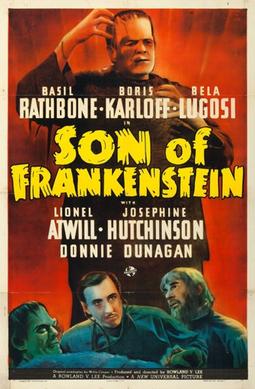
Son of Frankenstein is a 1939 American horror film directed by Rowland V. Lee and starring Basil Rathbone, Boris Karloff and Bela Lugosi. The film is the third in Universal Pictures' Frankenstein series and is the follow-up to the 1935 film Bride of Frankenstein. Son of Frankenstein stars Rathbone as Baron Wolf von Frankenstein who, with his wife Elsa and son Peter, returns to his late father's estate. Near the castle lives Ygor, a crazed blacksmith whose neck was broken in an unsuccessful hanging attempt. Among the castle's remains, Frankenstein discovers the remains of the Monster and decides to try to save his family name by resurrecting the creature to prove his father was correct. He finds, however, the Monster only responds to Ygor's commands.

Boris Karloff (1887-1969) was an English actor. He became known for his role as Frankenstein's monster in the 1931 Frankenstein, leading to a long career in film, radio, and television.
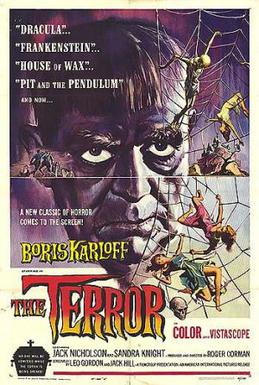
The Terror is a 1963 American independent horror film produced and directed by Roger Corman. The film stars Boris Karloff and Jack Nicholson, the latter of whom portrays a French officer who is seduced by a woman who is also a shapeshifting devil.
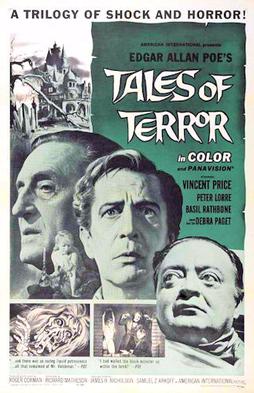
Tales of Terror is a 1962 American International Pictures comedy horror film in colour and Panavision, produced by Samuel Z. Arkoff, James H. Nicholson, and Roger Corman, who also directed. The screenplay was written by Richard Matheson, and the film stars Vincent Price, Peter Lorre, and Basil Rathbone. It is the fourth in the so-called Corman-Poe cycle of eight films, largely featuring adaptations of Edgar Allan Poe stories and directed by Corman for AIP. The film was released in 1962 as a double feature with Panic in Year Zero!.
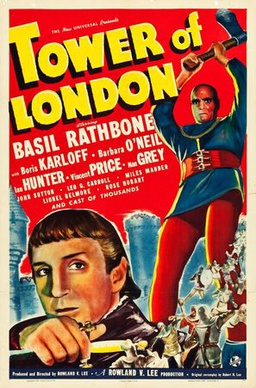
Tower of London is a 1939 black-and-white historical film directed and produced by Rowland V. Lee. It stars Basil Rathbone as the future King Richard III of England, and Boris Karloff as his fictitious club-footed executioner Mord. The film is based on the traditional depiction of Richard rising to become King of England in 1483 by eliminating everyone ahead of him. Each time Richard accomplishes a murder, he removes one figurine from a dollhouse resembling a throneroom. Once he has completed his task, he now needs to defeat the exiled Henry Tudor to retain the throne.

Ghost in the Invisible Bikini is a 1966 American fantasy comedy film. It is the seventh and last of American International Pictures' beach party films. The film features the cast cavorting in and around a haunted house and the adjacent swimming pool.

The Haunted Palace is a 1963 horror film released by American International Pictures, starring Vincent Price, Lon Chaney Jr. and Debra Paget, in a story about a village held in the grip of a dead necromancer. The film was directed by Roger Corman and is one of his series of eight films largely based on the works of American author Edgar Allan Poe.

Madhouse is a 1974 horror film directed by Jim Clark for Amicus Productions in association with American International Pictures. The film, which is a British-American co-production, stars Vincent Price, Natasha Pyne, Peter Cushing, Robert Quarry, Adrienne Corri, and Linda Hayden. The film was based on the 1969 novel Devilday by Angus Hall. The film's alternate title is The Revenge of Dr. Death.
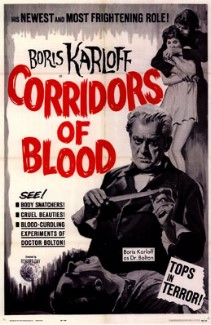
Corridors of Blood is a 1958 British-American period drama film directed by Robert Day and starring Boris Karloff and Christopher Lee. The original music score was composed by Buxton Orr.
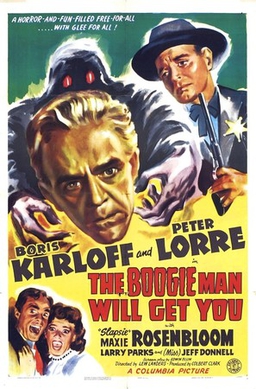
The Boogie Man Will Get You is a 1942 American comedy horror film directed by Lew Landers and starring Boris Karloff and Peter Lorre. It was the final film Karloff made under his contract with Columbia Pictures, and it was filmed in the wake of his success in the 1941 Broadway production Arsenic and Old Lace. As he had done several times previously, Karloff played the part of a "mad scientist", Professor Billings, who is using the basement of his inn to conduct experiments using electricity to create a race of superhumans. The inn is bought by a new owner, who is initially unaware of the work Billings is conducting.

Bikini Beach is a 1964 American teen film directed by William Asher and starring Frankie Avalon and Annette Funicello. The film belongs to the beach party genre of movies, popular in the 1960s. This is the third in the series of seven films produced by American International Pictures (AIP).
